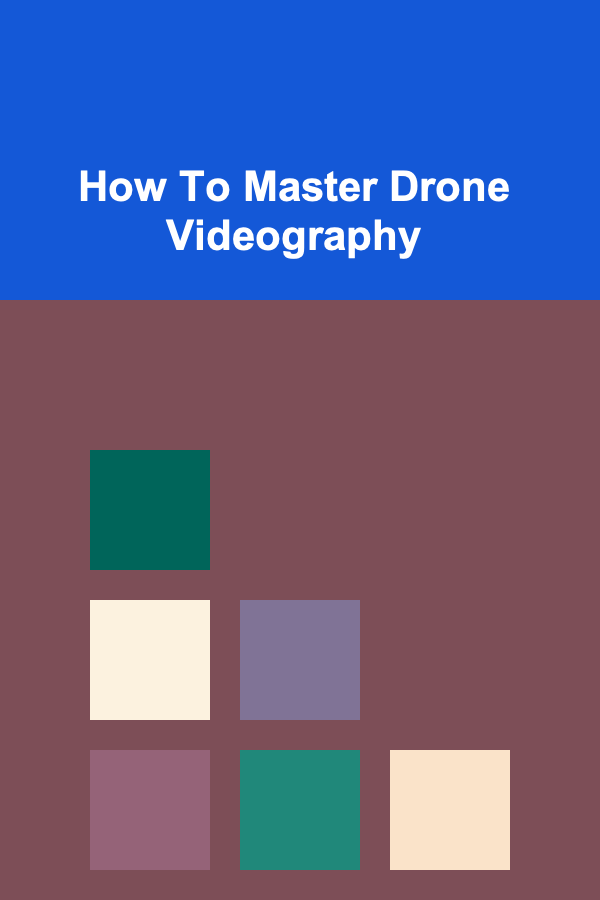
How To Master Drone Videography
ebook include PDF & Audio bundle (Micro Guide)
$12.99$11.99
Limited Time Offer! Order within the next:

Drone videography has revolutionized the way we capture footage, offering a bird's-eye view that would be impossible or impractical with traditional cameras. Whether you're an aspiring filmmaker, a hobbyist, or a professional photographer, mastering drone videography requires a blend of technical skill, creativity, and an understanding of how to manipulate both the drone and the environment. In this article, we will explore the key aspects of drone videography, from mastering the equipment to understanding the intricacies of filming techniques, post-production, and storytelling.
Understanding the Basics of Drone Videography
Drone videography is essentially the art of capturing video footage using a drone equipped with a camera. Unlike traditional videography, where the camera is typically stationary or handheld, drones provide a unique perspective by allowing you to capture smooth, sweeping shots from high above the ground. To master drone videography, it's essential to first understand the technology behind the drone and the equipment involved.
Types of Drones for Videography
There are various types of drones used in videography, each designed for different purposes and price points. The primary categories include:
- Entry-Level Drones: These are small, inexpensive drones ideal for beginners. They are often lightweight, easy to fly, and come with basic cameras. While their video quality may not match professional-grade equipment, they can be an excellent starting point for learning the basics of drone piloting and videography.
- Prosumer Drones: These drones strike a balance between affordability and performance. They often come with high-quality cameras, stabilization systems, and various intelligent flight modes, making them ideal for intermediate users or aspiring filmmakers.
- Professional Drones: These drones are designed for serious filmmakers and videographers. They feature high-end cameras, advanced stabilization technology, and a wider range of customizable options. They are capable of shooting in higher resolutions, such as 4K and even 6K, and offer more control over various filming parameters.
Key Components of a Drone
Before diving into videography techniques, it's important to understand the key components of a drone:
- Frame: The frame is the structure of the drone and supports all other components. It must be sturdy and lightweight to ensure stability during flight.
- Motors and Propellers: Motors are responsible for generating the thrust needed to lift the drone off the ground, while the propellers direct the airflow to achieve smooth and stable flight.
- Battery: The battery powers the drone and determines its flight time. Most drones have a flight time of 20 to 30 minutes, depending on the model and conditions.
- Camera and Gimbal: The camera is the heart of drone videography, capturing footage during flight. The gimbal stabilizes the camera, ensuring smooth and vibration-free footage, especially during rapid maneuvers or in windy conditions.
- GPS and Sensors: Modern drones come equipped with GPS systems and various sensors (e.g., obstacle avoidance, altitude sensors) that help stabilize the drone, ensure accurate positioning, and avoid collisions.
Mastering Drone Flight
Before you can produce cinematic aerial footage, you must first master the art of flying a drone. Effective drone piloting requires a combination of spatial awareness, technical knowledge, and controlled movements. Here are some key tips to help you become a skilled drone pilot:
1. Practice in Open Spaces
As with any new skill, practice is essential. Start flying in wide-open spaces where there are few obstacles. This will allow you to focus on mastering basic controls without the added pressure of avoiding trees, buildings, or other hazards.
2. Understand Drone Controls
Familiarize yourself with the basic drone controls:
- Throttle: Controls altitude (up/down).
- Yaw (Rotation): Rotates the drone clockwise or counterclockwise.
- Pitch (Tilt): Tilts the drone forward or backward.
- Roll (Movement): Moves the drone left or right.
Understanding these controls is essential for achieving smooth and precise movements during flight.
3. Use the Right Flight Modes
Modern drones come with several flight modes that help you achieve different types of footage. Some key flight modes include:
- Beginner Mode: This limits the drone's speed and altitude, making it easier for beginners to control.
- Sport Mode: Provides faster speeds and more agile maneuvers for experienced pilots.
- Follow Me Mode: The drone automatically follows you, keeping the camera focused on your movement.
- Waypoints Mode: Allows you to pre-program a flight path for the drone, which is useful for capturing smooth, repeatable shots.
4. Understand Wind Conditions
Wind is one of the biggest challenges when it comes to drone flight. While drones are generally stable in moderate winds, high winds can significantly affect flight performance and make videography difficult. Always check the weather before flying, and avoid flying in windy conditions, especially if you're a beginner.
Techniques for Capturing Stunning Drone Footage
Once you have mastered the basics of flying a drone, the next step is to focus on capturing professional-quality footage. Drone videography is all about utilizing the drone's unique abilities to create cinematic shots that are impossible with traditional cameras.
1. Mastering Camera Angles
The aerial perspective allows for a variety of unique angles that can add drama, depth, and dynamism to your footage. Some common drone camera angles include:
- Top-Down Shots: The camera points directly downwards, offering a bird's-eye view of the scene. This angle is perfect for capturing patterns, symmetry, or large landscapes.
- Low-Flying Shots: Flying close to the ground provides a sense of speed and immersion. It's ideal for following moving subjects, such as cars, people, or wildlife.
- Tracking Shots: These shots involve the drone flying alongside a moving subject, maintaining focus and framing. It's an effective way to capture fast-moving subjects while maintaining smoothness and stability.
- Cinematic Pull-Away: This shot involves flying the drone backwards and upwards, slowly pulling away from the subject to reveal a broader view of the scene. It's a popular technique for establishing shots.
2. Plan Your Shots
Unlike traditional videography, where you can easily reposition the camera, drone footage requires more thoughtful planning due to the drone's limited flight time and the complexity of its movements. Plan your shots in advance by scouting the location, considering lighting, and anticipating the movements you want to capture. Using a flight path or waypoint system can help create smooth, repeatable shots.
3. Utilize Slow Movements
One of the keys to achieving cinematic drone footage is to keep your movements slow and steady. Rapid, jerky movements can result in shaky footage that detracts from the professional quality you're aiming for. When flying the drone, aim to make slow, fluid movements to ensure the footage remains smooth and polished.
4. Work with Lighting
Lighting plays a critical role in creating high-quality video. The best times for drone videography are during the "golden hours" --- the first hour after sunrise and the last hour before sunset. During these times, the light is softer and warmer, creating more dynamic visuals and a more flattering look.
Avoid shooting in the harsh midday sun, which can lead to overexposure and harsh shadows. If possible, shoot on cloudy days, as the diffused light will result in more even and aesthetically pleasing footage.
5. Use ND Filters
Just like with traditional camera videography, neutral density (ND) filters can help you achieve smoother footage. ND filters reduce the amount of light entering the camera lens, allowing you to use slower shutter speeds without overexposing the image. This is particularly important when shooting in bright daylight or during high-speed maneuvers.
Post-Production Techniques
Once you've captured your footage, the next step is editing and refining the video. The power of drone videography often shines in post-production, where you can enhance the visuals, add transitions, and create a more polished final product.
1. Color Grading
Color grading is a vital aspect of post-production, as it allows you to adjust the colors and tones of your footage to match your desired aesthetic. Drones often capture raw, flat footage, which gives you more flexibility when it comes to color correction. You can use software like Adobe Premiere Pro, Final Cut Pro, or DaVinci Resolve to adjust the brightness, contrast, saturation, and other parameters to make your footage pop.
2. Stabilization
Even with advanced gimbals, some minor shakes may occur during flight. Stabilizing the footage in post-production can help smooth out any unwanted motion. Most editing software comes with built-in stabilization tools that can reduce jitter and shakiness.
3. Adding Music and Sound Design
Sound plays an essential role in creating an immersive viewing experience. When editing your drone footage, consider adding a fitting soundtrack and sound effects that complement the visuals. Music can help set the tone, while environmental sounds (such as wind or traffic) can add realism to your footage.
4. Transitions and Effects
Transitions between different shots can elevate the storytelling aspect of your drone video. Smooth fades, wipes, or creative transitions can help the video flow seamlessly from one shot to the next, maintaining the audience's engagement.
Final Thoughts: Mastering Drone Videography
Mastering drone videography requires dedication, practice, and a deep understanding of both the technical and creative aspects of filming. From learning to fly the drone and capturing breathtaking aerial shots to editing and refining the footage, every step plays a role in creating cinematic, professional-grade content.
As you gain more experience, experiment with different techniques, shooting styles, and post-production workflows. The key is to keep practicing, stay inspired, and push your creative boundaries. Drone videography opens up endless possibilities, and with time and effort, you'll be able to create stunning visual stories from the skies.
Reading More From Our Other Websites
- [Mindful Eating Tip 101] From Cravings to Conscious Choices: A Practical Mindful Eating Checklist
- [Organization Tip 101] How to Organize Your Photography Equipment at Home
- [Home Budget 101] How to Create a Meal Planning Budget to Save on Groceries
- [Stamp Making Tip 101] Creative Stamp-Making Techniques to Elevate Your Handmade Greeting Cards
- [Beachcombing Tip 101] Shell Hunting 101: Tips for Finding and Identifying Ultra‑Rare Sea Shells
- [Organization Tip 101] How to Create a Home Office That Inspires Productivity
- [Home Budget Decorating 101] How to Create a Cozy Space on a Budget in Your Bedroom for Better Sleep
- [Biking 101] Bike Stem Explained: What It Does and Why It's Important
- [Gardening 101] Kitchen Garden Hacks: How to Maximize Your Harvest in Limited Space
- [Personal Investment 101] Earning Money with AI: How to Make Passive Income with Deep Learning

How to Create a Festive Atmosphere with Holiday Scents
Read More
How to Maintain Work-Life Balance with Effective Time Management
Read More
How to Make a Checklist for Selecting the Right Research Methodology
Read More
How to Maximize Bedroom Space with Space-Saving Furniture Ideas
Read More
How to Pitch Your Business to Investors
Read More
How to Use a Knitting Planner to Track Your Progress and Stay Motivated
Read MoreOther Products

How to Create a Festive Atmosphere with Holiday Scents
Read More
How to Maintain Work-Life Balance with Effective Time Management
Read More
How to Make a Checklist for Selecting the Right Research Methodology
Read More
How to Maximize Bedroom Space with Space-Saving Furniture Ideas
Read More
How to Pitch Your Business to Investors
Read More